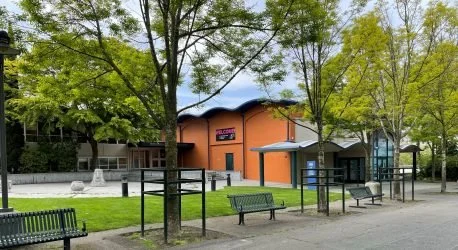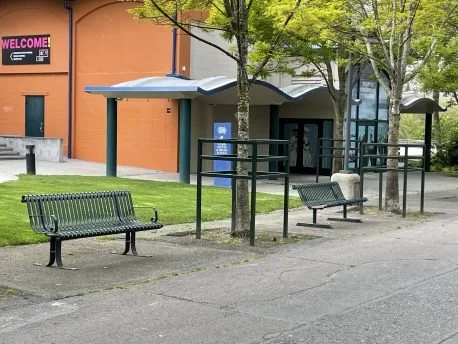The Nile Temple Building at Seattle Center
By Michael Herschensohn
Just the other day, I celebrated my granddaughter's birthday at the former Nile Temple Building watching a delightful play in the Eve Alvord Theatre. The outing reminded me of the building’s interesting history. Now folded into the Seattle Children’s Theatre, the L-shaped building located at the former intersection of Third Ave. N. and Thomas St. tells stories about the evolution of Seattle Center that are fun to remember and best not forgotten.
Constructed in 1956 to serve as the headquarters of the Seattle Shriners, the Nile Temple Building is the work of Samuel G. Morrison & Associates. Morrison (1915-1992) designed office buildings in Seattle. Since the Nile Temple had over 11,000 members when they selected this site, I am guessing he too was a Shriner. The Shriners are a fraternal Masonic order, founded in New York City in 1872, and as its name suggests (Ancient Arabic Order of the Nobles of the Mystic Shrine for North America), to introduced fun into the sometimes-stiff rites of Masonic lodges. Dedicated to fun, fellowship and philanthropy (three mission goals that all start with the same letter), the Shriners are well known for the hat or ‘fez’ members wear and for the hospitals they began building in 1922 to address the needs of children handicapped by polio. Seattle Shriners founded the Nile Temple in 1909. By 1956, they were the largest Shriner temple in the world. The big draw of the Thomas St. location was its proximity to the Civic Auditorium (now McCaw Hall) where the Shriners held conventions twice a year following large parades. Seattle’s chapter invested their resources in the golf course just over the county line at 205th St. at Lake Ballinger.
Originally, single family homes surrounded the site of the Nile Temple. They are visible in the background of the 1957 photographs and give a sense of what Seattle Center looked like before the 1962 fair. The simple two-story concrete block building sports a waving concrete roof line, which may suggest the ‘fun’ in the Shriners’ mission. It may be going too far, but the sign over the main entrance to the building read ‘Smile with Nile,’ and the curved line of the roof might just be a smile. Indeed, the thin shell concrete slabs of the roof line are the building’s must distinctive architectural features. The entrance pavilion to the auditorium/dining facility repeats that happy wavy line which may presage the feats achieved through daring concrete construction by the structural engineers of the Century 21 Exposition, aka the 1962 Seattle World’s Fair. The Space Needle, the United States Science Pavilion (Pacific Science Center) and the Washington State Coliseum (Climate Pledge Arena) are examples of the exciting concrete structures developed for the fair.
In 1957, the planners of the Century 21 Exposition intended to take the brand-new Nile Temple, the Warren Avenue Elementary school and the full block of the Sacred Heart Parish buildings west of Second Avenue N. by eminent domain. In fact, the Seattle, World's Fair Commission condemned much of the surrounding land as far south as Denny Way and as far west as First Ave. N. Sixteen property owners, including the Shriners, the school district and the Archdiocese of Seattle which owned Sacred Heart appealed to the state Supreme Court a King County Superior Court decision allowing the condemnation. According to the Seattle Post-Intelligencer of July 8, 1958, the World Fair Commission decided to drop the condemnation suits. Anecdotal though the information may be, the archbishop threatened to unleash countless influential members of the Catholic Church against the plans for the fair, and with 7,000 of its 11,000 members living in Seattle, there were just too many powerful Shriners to confront as well. (Carla Becker and Alan Stein, The Future Remembered, p. 24). The truth seems to be that the commission’s funds were dwindling more quickly than expected as land values had gone up since making the initial plans for the fair. Reducing the physical size of the grounds to about seventy-three acres saved money that would fund required buildings instead. In the end, the fair commission omitted the four blocks that included Sacred Heart, bought and demolished the Warren Avenue Elementary School to make room for the Washington State Coliseum and leased the Nile Temple Building for the duration of the fair.
During the fair, the Nile Temple Building served as the 21 Club for wealthy Seattleites and high-ranking fair visitors and exhibitors. According to Alan Stein and Carla Becker in The Future Remembered, “Members enjoyed dining facilities, meeting rooms, showers and barbershop; switchboard, paging, and stenographic services; and nightly entertainment (p. 243)." The 21 Club capitalized on the 700-seat auditorium, which could accommodate five hundred diners as a banquet facility. That facility, the blocky structure on the building’s northeast corner, is now the Eve Alvord Theatre.Over the summer of 1962, the Christian Witness Building & Child Care Center filled the former parking lot along Third Ave. N. It was demolished after the fair; however, the city continued to lease the Nile Temple Building until 1979, when it bought the building from the Shriners and leased half to the Seattle Children’s Theatre that was being squeezed out of its site at the Zoo. The other half of the building was leased to the Pacific Arts Center to provide afterschool and weekend art classes for children. Founded in the 1950s by Ruth Lease as the Creative Activities Center, at Seattle Center, it fell under the direction of board members Anne Gould Hauberg and Virginia Wyman, both fierce “believers that creativity is an important and empowering part of all of our lives.”
During the decades of the 1970s and 80s, Seattle Center struggled to define its purpose. The civic center imagined for the fair site had a tough time, for it depended on the city’s annual budget which naturally put the need for new fire engines above more frivolous activities at Seattle Center. Mayors came and went without solving the problem of how to attract organizations and people to Seattle Center. One strategy focused on providing cheap rent to children’s organizations. The Pacific Arts Center relocated as a result to the Nile Temple Building and managed to operate through the early 1990’s when, unable to pay the rent, the city forced it out. The Seattle Children’s Theatre began moving from the Woodland Park Zoo to the Nile Temple Building in 1987 and started producing plays in the former auditorium/dining hall while conducting classes and setting up offices in converted classrooms. With the addition of the Charlotte Martin Theatre in 1993 and Allen Family Technical Pavilion for rehearsal space, classrooms and shops in 1995, the Nile Temple Building lost its prominent place on the block.
Today, even though the two new buildings overshadow the Nile Temple Building, it continues after sixty-six years to bring adults and children together sometimes to appreciate the value of the arts as they did at the Pacific Arts Center and sometimes just to have fun as they “Smile at the Nile!”
Sources:
Becker, Paula and Alan Stein, The Future Remembered The 1062 World’s Fair and its Legacy, Seattle Center Foundation 2011.
Seattle Public Library, Special Collections Online, Digital Photograph Collection.
Century 21 Digital Collection. Werner Leggenhager photographer of Nile Temple Building.
Seattle Public Library, Magazines & Newspapers Online: Seattle Post-Intelligencer, 1901-Present. Editions of July 2, 5, and 8, 1958.
Seattle.gov. Department of Neighborhoods, Seattle Historical Sites, Summary for 201 Thomas ST / Parcel ID 1985200185 / Inv # CTR014
Cathy Wickwire, Survey Report: Comprehensive Inventory of City-Owned Historic Resources, Seattle, Washington, 2001, pp. 19-22.
Virginia Wyman, Email of May 16, 2022.






